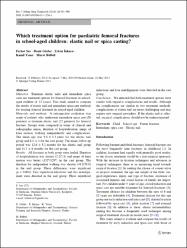| dc.contributor.author | Say, Ferhat | |
| dc.contributor.author | Gürler, Deniz | |
| dc.contributor.author | İnkaya, Erkan | |
| dc.contributor.author | Yener, Kamil | |
| dc.contributor.author | Bülbül, Murat | |
| dc.date.accessioned | 10.07.201910:49:13 | |
| dc.date.accessioned | 2019-07-10T19:36:32Z | |
| dc.date.available | 10.07.201910:49:14 | |
| dc.date.available | 2019-07-10T19:36:32Z | |
| dc.date.issued | 2014 | en_US |
| dc.identifier.citation | Say, F., Gürler, D., İnkaya, E., Yener, K. ve Bülbül, M. (2014). Which treatment option for paediatric femoral fractures in school-aged children: Elastic nail or spica casting? European Journal of Orthopaedic Surgery and Traumatology, 24(4), 593-598. https://dx.doi.org/10.1007/s00590-013-1234-x | en_US |
| dc.identifier.issn | 1633-8065 | |
| dc.identifier.uri | https://hdl.handle.net/20.500.12511/1189 | |
| dc.identifier.uri | https://dx.doi.org/10.1007/s00590-013-1234-x | |
| dc.description.abstract | Objective: Titanium elastic nails and immediate spica casts are treatment options for femoral fractures in school-aged children (6-12 years). This study aimed to compare the results of elastic nail and immediate spica cast methods for treating femoral fractures in school-aged children. Materials and methods: A retrospective evaluation was made of patients who underwent immediate spica cast (20 patients) or titanium elastic nail (22 patients) for femoral fracture. Groups were compared in terms of clinical and radiographic union, duration of hospitalisation, range of knee motion, walking independently and complications. The mean age was 9.8 ± 1.3 years for the elastic nail group and 6.4 ± 1 for the cast group. The mean follow-up period was 12.6 ± 5.2 months for the elastic nail group and 14.3 ± 6 months for the cast group. Results: All fractures in both group were healed. Duration of hospitalisation was shorter (2.2/7.1) and range of knee motion was better (132°/129°) in the cast group. The duration for independent walking was shorter (49.2/79.8) in the nail group. These differences were significant (p < 0.001). Two superficial infections and two malalignment were detected in the nail group. Three superficial infections and four malalignment were detected in the cast group. Conclusion: We detected that both treatment options were similar with regard to complications and results. Although the complications are similar in two treatment methods, complications of elastic nail are more challenging and may require new surgical procedure. If the elastic nail is selected, surgical complications should not be underestimated. | en_US |
| dc.language.iso | eng | en_US |
| dc.publisher | Springer-Verlag France | en_US |
| dc.rights | info:eu-repo/semantics/openAccess | en_US |
| dc.subject | Child | en_US |
| dc.subject | Elastic Nail | en_US |
| dc.subject | Femur Fracture | en_US |
| dc.subject | Immediate Spica Cast | en_US |
| dc.subject | School Age | en_US |
| dc.title | Which treatment option for paediatric femoral fractures in school-aged children: Elastic nail or spica casting? | en_US |
| dc.type | article | en_US |
| dc.relation.ispartof | European Journal of Orthopaedic Surgery and Traumatology | en_US |
| dc.department | İstanbul Medipol Üniversitesi, Tıp Fakültesi, Cerrahi Tıp Bilimleri Bölümü, Ortopedi ve Travmatoloji Ana Bilim Dalı | en_US |
| dc.identifier.volume | 24 | en_US |
| dc.identifier.issue | 4 | en_US |
| dc.identifier.startpage | 593 | en_US |
| dc.identifier.endpage | 598 | en_US |
| dc.relation.publicationcategory | Makale - Uluslararası Hakemli Dergi - Kurum Öğretim Elemanı | en_US |
| dc.identifier.doi | 10.1007/s00590-013-1234-x | en_US |
| dc.identifier.scopusquality | Q3 | en_US |


















